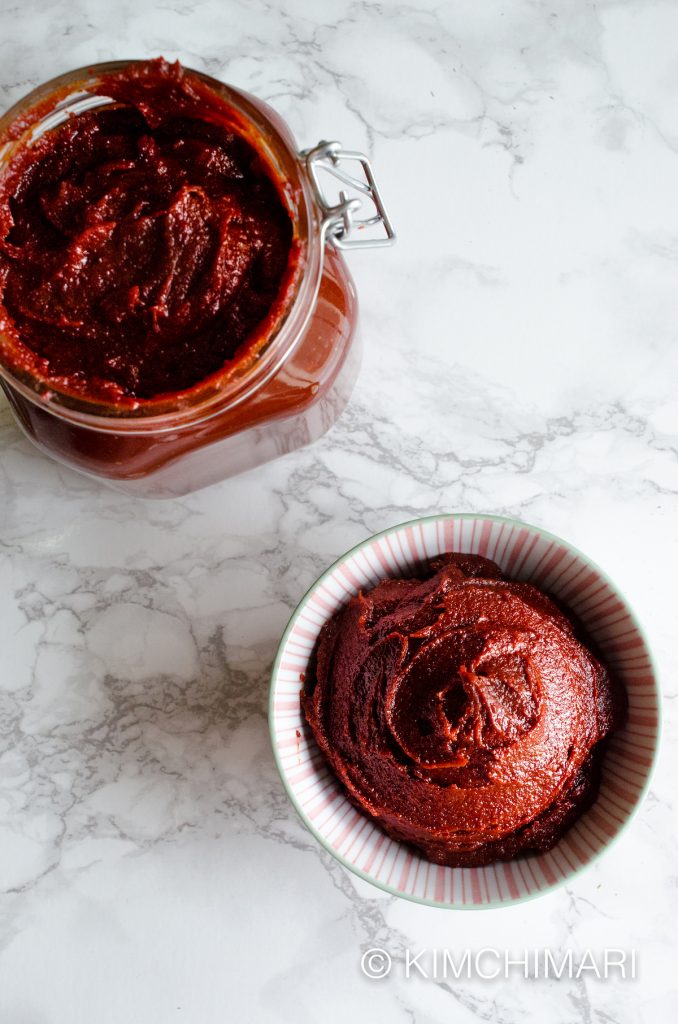
Homemade gochujang recipe that allows you to have a ready-to-eat gochujang in just a couple hours! What? That’s almost instant in the Korean fermentation world!! Is that possible?? Is it any good? You may ask… And my answer is YES and Yes, I mean, it’s pretty good considering it is ready in just few hours vs months.
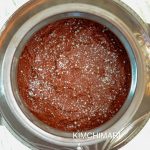
BTW, if you want to go all the way and make it the slow, traditional way using yeotgireum, try my very popular traditional gochujang recipe.
So I have to say I was pretty skeptical when I first learned this easy and quick homemade gochujang recipe from a temple food instructor Ms. Han a few years back while in Korea. I first met her while attending a temple food (sachal eumsik 사찰음식) class. Afterwards we kind of became friends… During class, she shared on how temple food helped her regain her health after having suffered with various health issues for so many years. Several years before, she said she was an art student in Italy and because she was so busy with her studies, she did not even have time to grocery shop properly let alone cooking for herself. So she said she ate just canned and instant foods all the time. Little by little, her health started to deteriorate with skin issues and other stomach issues. Things got so bad that she had to give up her studies and come back home to Korea. After coming back to Korea, she tried everything to cure her illnesses but nothing really helped until she decided to totally change her diet and went fully into temple food. She said after 6 months or so of cooking and eating temple food, her health slowly got back to normal and now, although she still has sensitive skin, she told us that she has no other health issues. So, naturally, she became a fan of temple food!
In 2014, when I opened my cooking studio in Seoul, she shared this easy and quick ready-to-eat gochujang recipe as a gift to me. And I was recently reminded of this recipe while I was making my gochujang for this year. I know this instant homemade gochujang recipe will never have the complex flavors that my authentic gochujang recipe (also on my blog) will develop over time but I know that this easy homemade gochujang recipe is still much better than the store bought ones – both in terms of flavor and health (no corn syrup and very little gluten).
The main difference between the two recipes is the milled malt barley. This quick and easy homemade gochujang recipe does not use any milled malt barley but just uses Korean rice syrup (jocheong 조청). But jocheong is made from rice and milled malt barley (yeotgireum 엿기름) so in some ways we are not going too far off the original recipe.
BTW, when I say ‘quick’, I mean quicker than my original recipe. 2 days + months of fermentation VS 2 hrs + few days of fermentation (optionally).
So here’s how you can make your own –
EASY HOMEMADE GOCHUJANG RECIPE
Makes: 4 cups Total Time: 2:40 hrs (Active: 40 min) Difficulty: Easy
Ingredients (** you can buy all the needed ingredients from my store – see Fermentation category)
- 2 C Korean gochukaru for gochujang (fine chili powder for gochujang) 고운고추가루
- 1.5 C meju powder (fermented soybean powder)
- 1/2 C sweet rice flour
- 1/2 C sea salt
- 1 C rice syrup (jocheong)
- 3.5 C water
- 1 Tbs green plum syrup (maesil cheong) – optional
- soju or sake – optionally if too thick
- In a pot (preferable flat bottomed and uniform sides), mix water and sweet rice flour. Mix it well with a whisk. Bring to boil, stirring often to prevent any lumps from forming and to make a paste. (much like sweet rice paste for kimchi)
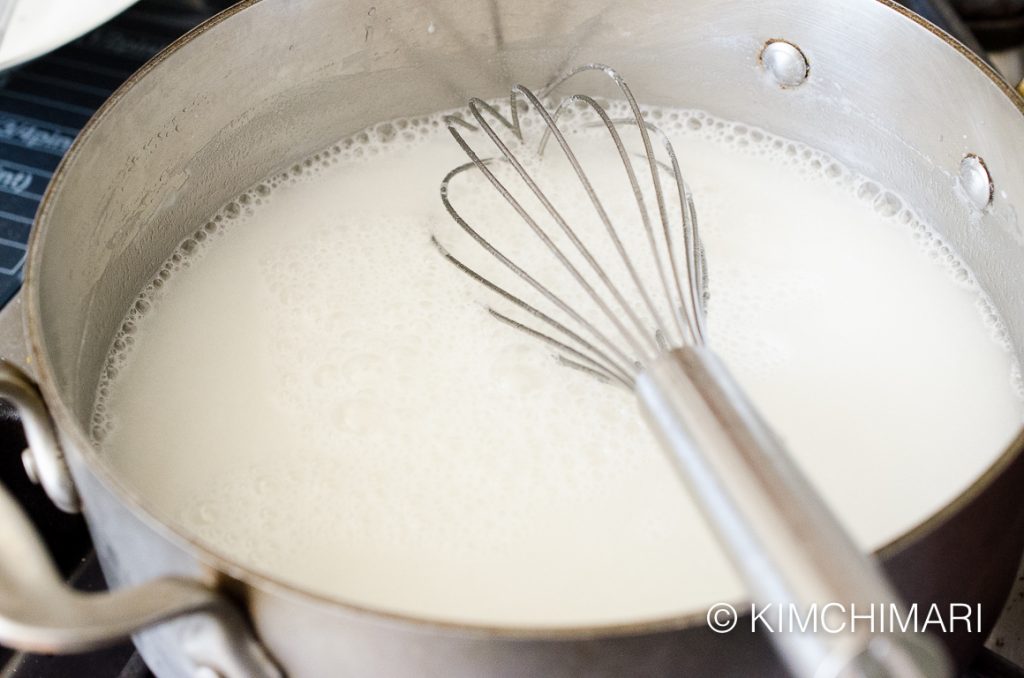
sweet flour and water in pot for gochujang - When it starts to boil, reduce heat and simmer for 10 min. or so until it is fully thickened to a paste. Stirring often to avoid lumps.
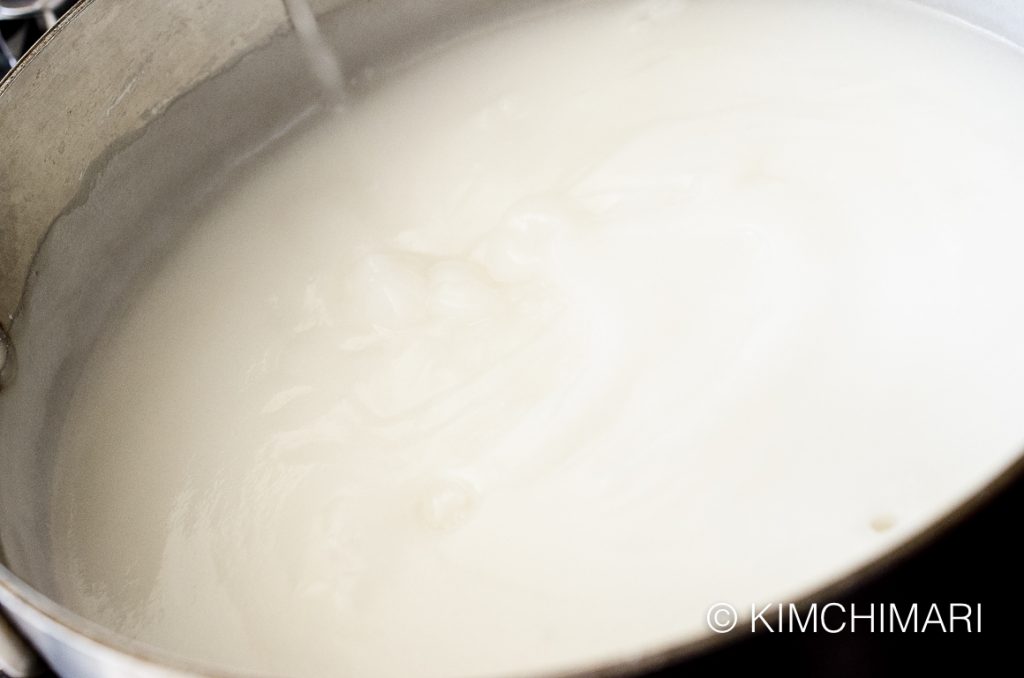
sweet flour paste for gochujang - Add 1 cup rice syrup to sweet rice flour paste and mix. You can add more if you want a sweeter gochujang.
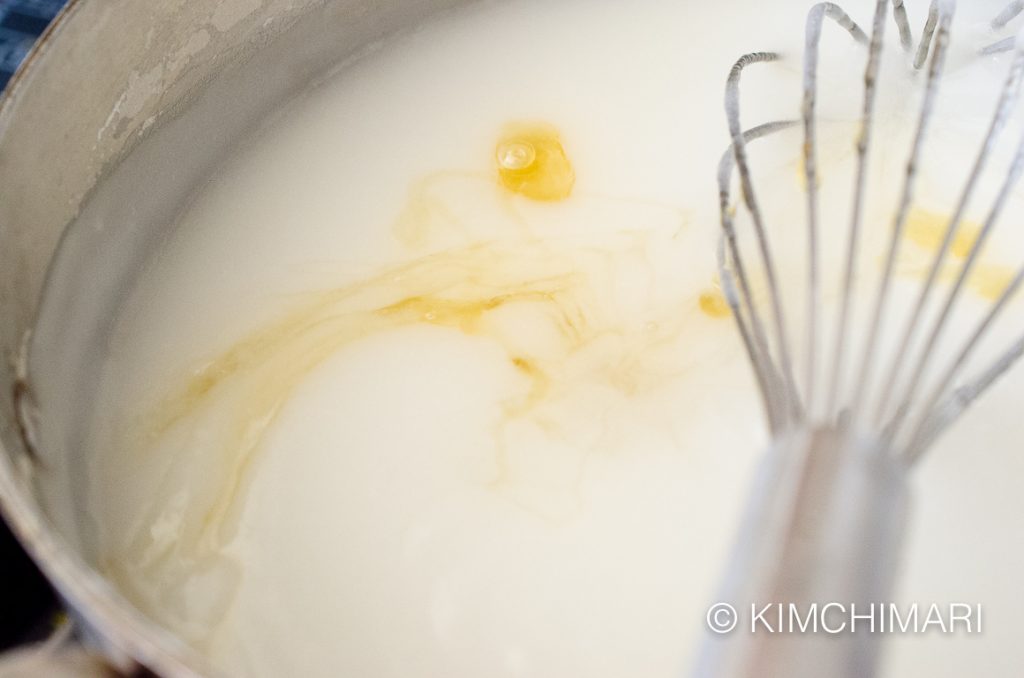
rice syrup in sweet rice paste Once you mix the syrup, the paste will become watery, no longer thick. That’s fine. Just continue to simmer for another 20-25 minutes until the volume reduces about 20%. Tip – you can measure the 20% reduction of liquid by using a chopstick to measure the height of the pot at the beginning and throughout. So if the height was 10 cm to start, you can stop when it is 8 cm. Note this will work only if you have a pot that is uniform in shape i.e. the diameter of the bottom and top of the pot is the same.
- Turn off heat and let it cool.
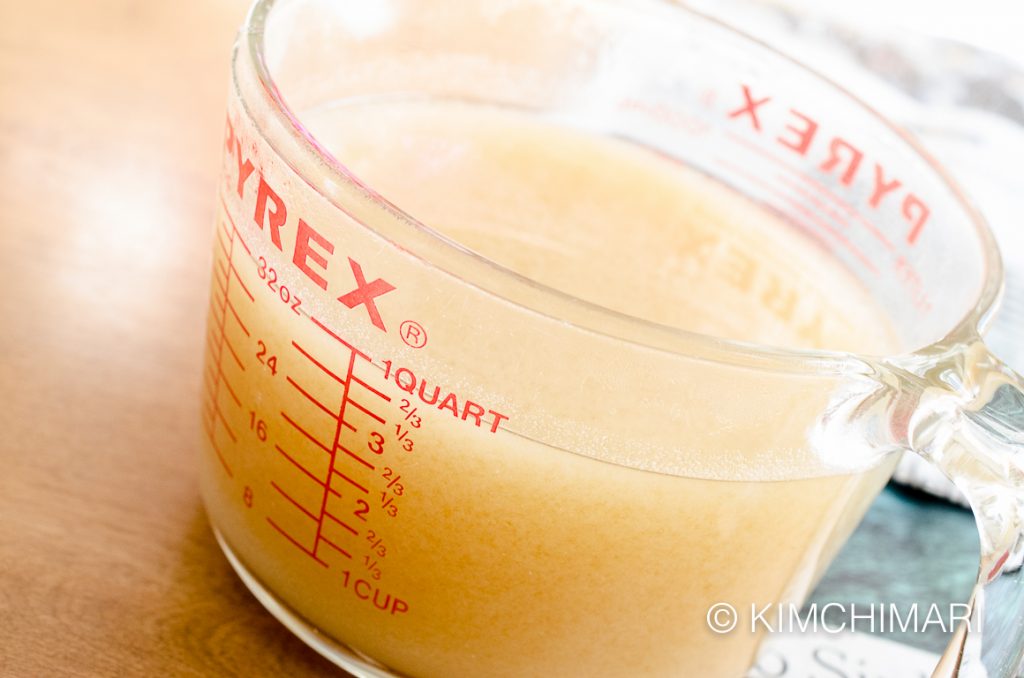
rice syrup sweet flour liquid for gochujang recipe Cooling time will be different based on your room temperature but for me it took about 2 hrs to cool the rice paste + rice syrup mixture from 3. It doesn’t have to be cold, just room temp. I transferred it to this glass measuring cup to cool it more quickly. You can always cool it in the fridge or in an ice bath to shorten the cooling time.
- Add meju powder, chili powder and salt to cooled rice syrup liquid.
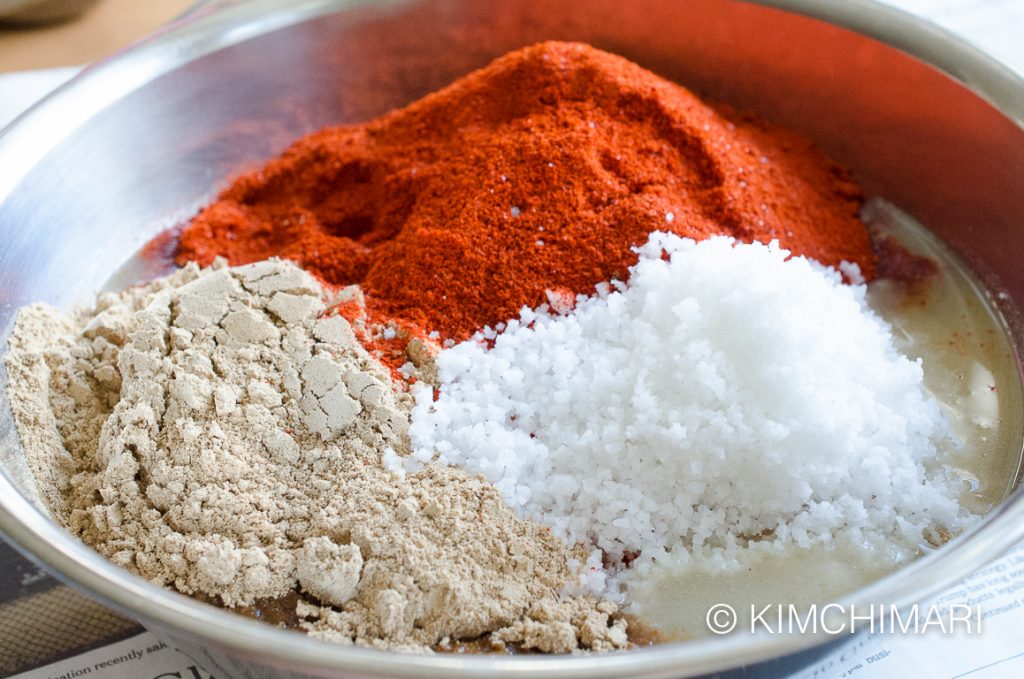
meju chili powder salt for gochujang - Use a whisk and mix everything well until there are almost no lumps.
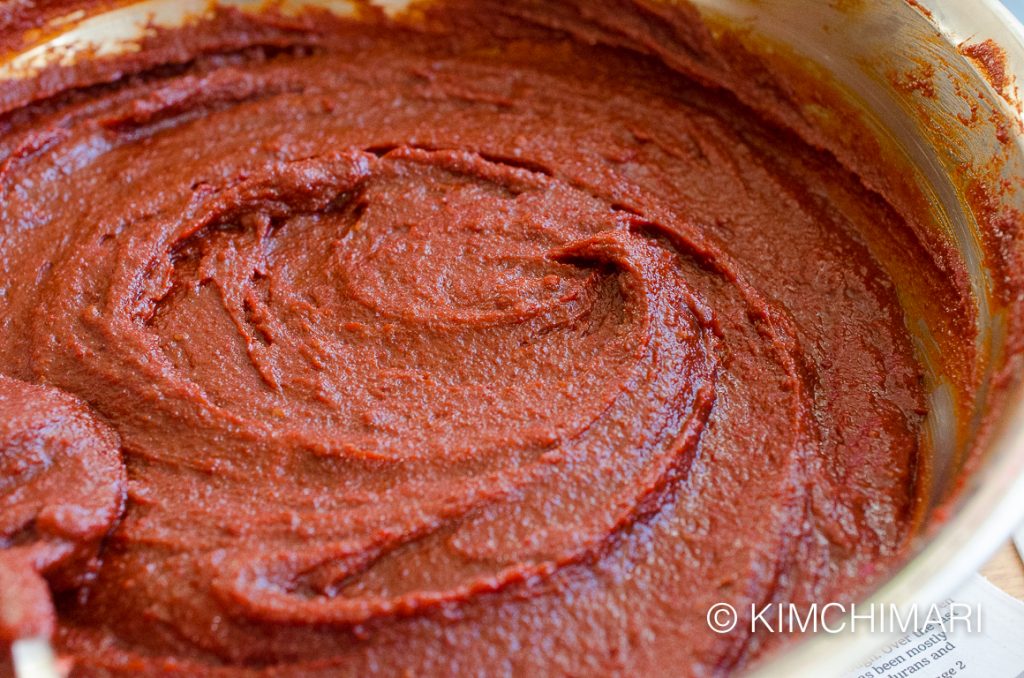
easy gochujang recipe mix - And there you go! You now have instant gochujang that you can use right away!!
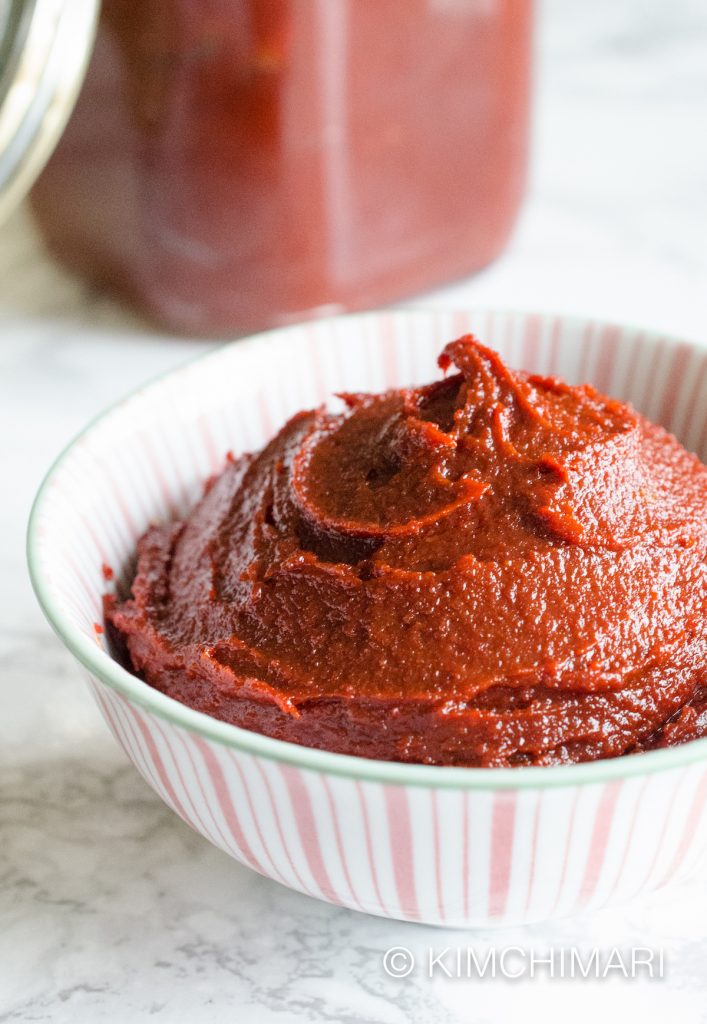
Easy Homemade Gochujang Recipe
Easy Homemade Gochujang Recipe That’s Almost Instant!
Ingredients
- 2 C Korean gochukaru for gochujang (fine chili powder 고추가루 for gochujang)
- 1.5 C meju powder (fermented soybean powder)
- 1/2 C sweet rice flour
- 1/2 C Sea Salt (Trader Joe's)
- 1 C rice syrup (jocheong)
- 3.5 C water
- 1 Tbsp green plum syrup (maesil cheong) – optional
Instructions
- In a pot (preferable flat bottomed and uniform sides), mix water and sweet rice flour. Mix it well with a whisk. Bring to boil, stirring often to prevent any lumps from forming and to make a paste. (much like sweet rice paste for kimchi)
- When it starts to boil, reduce heat and simmer for 10 min. or so until it is fully thickened to a paste. Stirring often to avoid lumps.
- Add 1 cup rice syrup to sweet rice flour paste and mix. You can add more if you want a sweeter gochujang.
- Turn off heat and let it cool.Cooling time will be different based on your room temperature but for me it took about 2 hrs to cool the rice paste + rice syrup mixture from 3.
- Add meju powder, chili powder and salt to cooled rice syrup liquid.
- Add meju powder, chili powder and salt to cooled rice syrup liquid.
- Use a whisk and mix everything well until there are almost no lumps.
- Let your gochujang mature a little more for 2-3 days in the fridge or at cool temperature before using it for even more flavor.
Tips & Notes:
- This is NOT the traditional gochujang recipe where it's meant to ferment for months outside in the sun. This is meant to be consumed pretty quickly and will not change much in flavor over time and may not last very long (i.e. will not have the deep ripened flavor)
- Buy special fine chili powder that is made specifically for gochujang (고추장용) or grind it very fine, like ground black pepper.
- It is important that the rice paste is cooled (not cold but room temp). If you add meju powder to hot liquid, the smell of meju powder will be too strong.
- If gochujang mixture seems to be too thick, you can add 1-3 Tbs of sake or soju. Mine came out a little on the thick side - I like mine that way.
- If you have maesil cheong (green plum syrup), you can add 1-2 Tbs for added flavor and sweetness. Now, you have Maesil flavored Gochujang. You can make your own maesil cheong or buy it. Substitute corn syrup or Oligodang syrup instead if you can't get maesil syrup.
Nutrition Information:
Notes
- This is NOT the traditional gochujang where it’s meant to ferment for months outside in the sun. This is meant to be consumed quickly.
- Buy special fine chili powder that is made specifically for gochujang (고추장용) or grind it very fine, like ground black pepper.
- It is important that the rice paste is cooled (not cold but room temp). If you add meju powder to hot liquid, the smell of meju powder will be too strong.
- If gochujang mixture seems to be too thick, you can add 1-3 Tbs of sake or soju. Mine came out a little on the thick side – I like mine that way.
- If you have maesil cheong (green plum syrup), you can add 1-2 Tbs for added flavor and sweetness. Now, you have Maesil flavored Gochujang. You can make your own maesil cheong or buy it.
Well, I hope you enjoy this easy gochujang recipe!
XOXO,
JinJoo
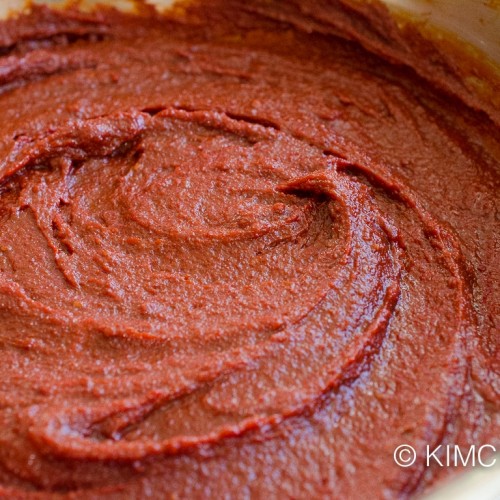
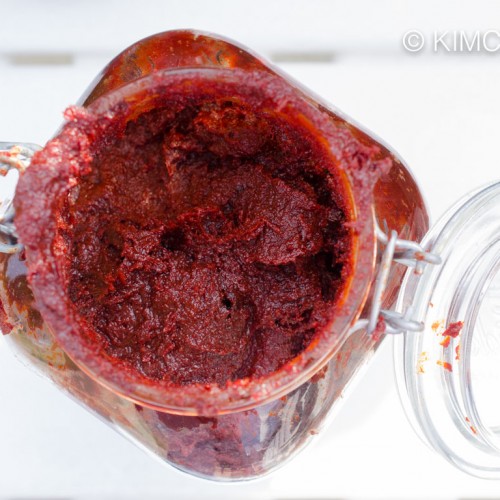
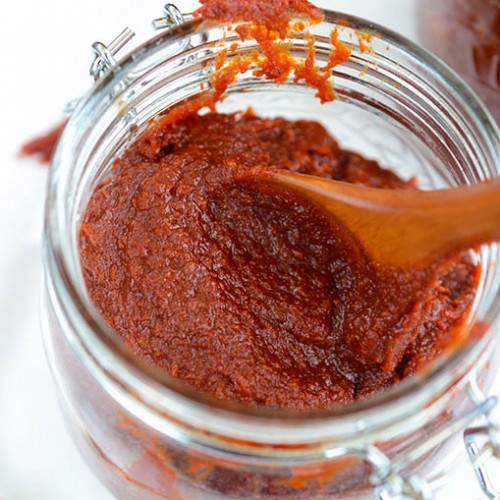

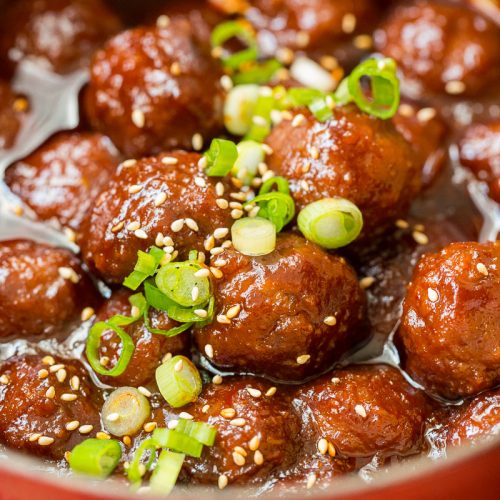
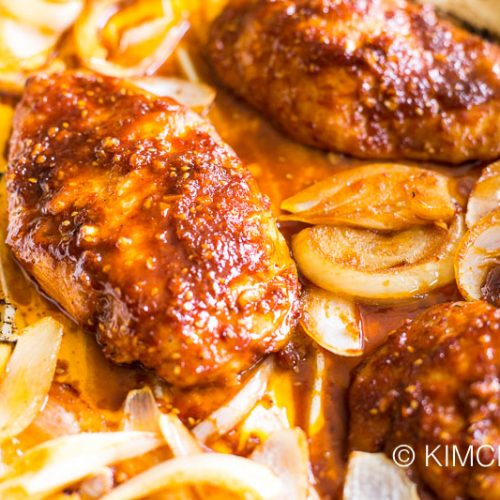
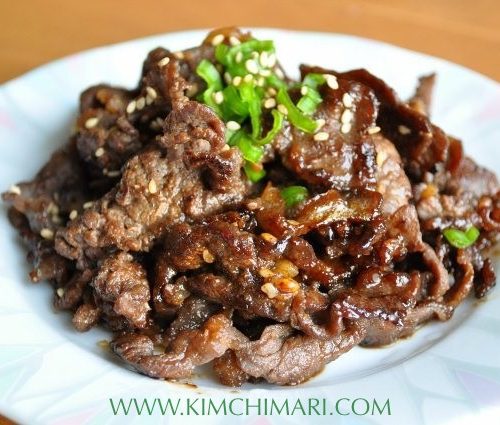
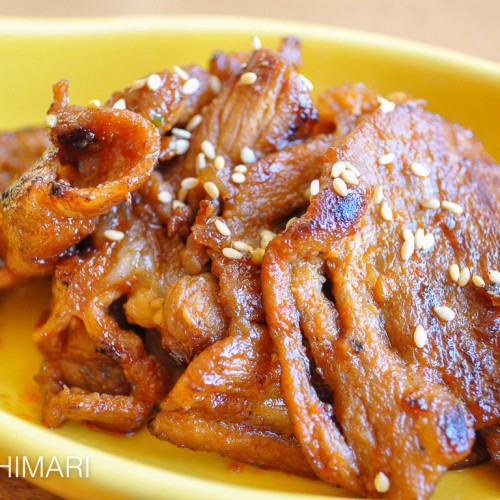
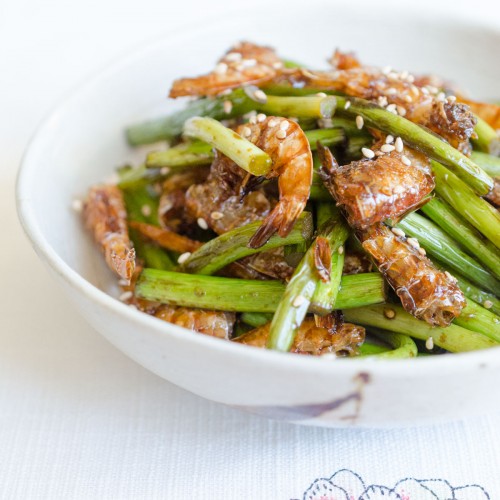

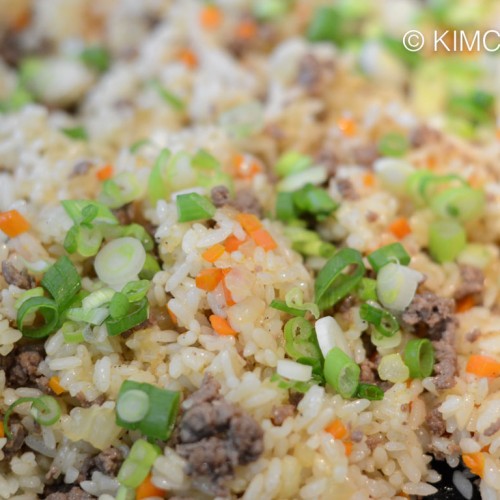
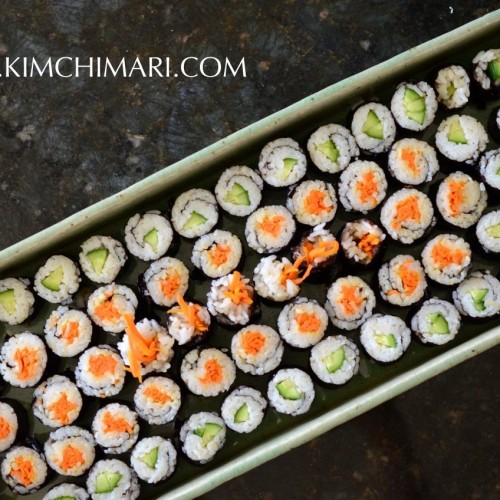
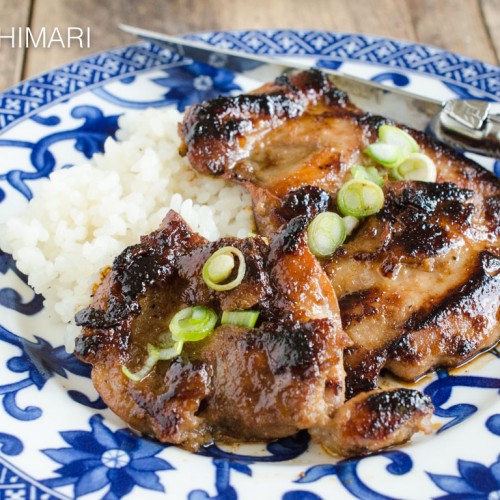








Thanks for this and am lookint to try the quick version for a start.
I didn’t see this in the comments but: what is the storage life on the finished product? Also, store in the fridge?
Thanks
Great question – The storage life of this finished product is not very long – probably 2-3 months or so. And definitely it should be stored in the fridge, unlike the traditional full version.
How are you, Jin Joo?? 🙂 I definitely will try this recipe. Thank you so very much for the instant version! I can finally have a proper bibimbap. When I have bibimbap in Korean restaurants, I will omit the sauce as it has got garlic and alcohol. Instead, I asked for sesame oil and soy sauce…not too bad. Last bibimbap I had was with teriyaki sauce…boy oh bóy…don’t try this 🙂
Question… Is fermented soybean powder = natto powder? I’ve read one of the above comments posted back in 2017 that she couldn’t find fermented soybean powder in KL. I’ll be back in KL next Wednesday. So just in case that there’s no fermented soybean powder in any of the Korean supermarket, can I use natto powder? Otherwise I’ll need to ask my friend who’s traveling in South Korea now to get me a pack of fermented soybean powder lol
Many thanks!
Hi Anwen, no, fermented soybean powder is NOT natto powder. Fermented soybean powder is powder made from crushed meju (soybean blocks). Natto is something different. I think it would be best for you to ask your friend to buy you a bag of Meju powder from Korea. Good luck!
Hi JinJoo! I cannot eat any soy, devastating to my Korean food obsession!, and I’m wondering if there is a replacement for the soybean powder or if I could omit it? Thanks.
Hi Jeni, I’m so sorry to hear that you cannot eat soy. I am afraid I just don’t know if you can make it without soy. It would be the same as trying to make chicken soup without chicken? Soy is what gives gochujang it’s unique funky and umami flavor. I am afraid I just don’t have any replacement for you. Sorry about that. Thank you.
Excellent Recipe. I was trying to avoid Corn Syrup and limit the sugar which is impossible to do. This was truly an excellent recipe but easy to execute. Thanks.
I’m very happy to hear that my recipe enabled to make the version you wanted. I try to avoid corn syrup as much as I can too. Thank you!
Hai, Thank you so much for your recipe. In my country (Malaysia) hard to find fermented soy bean, so i change it to miso paste. Since the miso already salty, i didnt put any salt. Can it achieve the same taste? Thanks
I can’t say it will have the same taste but should be similar. It’s hard to say because all miso paste is different.